Found a total of 10000 related content

What are the different types of input fields (text, password, email, number, date, checkbox, radio, file, submit, reset)?
Article Introduction:Common input fields for web forms include text, password, email, number, date, radio boxes, check boxes, file upload, submit buttons and reset buttons. 1. Text input (text) is used to freely enter text content, requiring additional verification; 2. Password input (password) hides user input and is often used with confirmation of passwords; 3. Email input (email) automatically checks the format, mobile adaptation optimization; 4. Number input (number) limits input to numbers and supports setting range and step size; 5. Date selection (date) provides calendar controls to improve experience, but compatibility needs to be considered; 6. Radio box (radio) is used for multi-option radio, and the name attribute must be consistent; 7. Checkbox (checkbox) is used for multiple
2025-06-26
comment 0
902

What are the different types of form input elements (text, password, radio, checkbox, select, textarea)?
Article Introduction:When building a web form, you should select the appropriate input element according to the required data type. 1. Text input is used for short text such as name or email, and is used with placeholders, maximum character restrictions and labels; 2. Password field hides user input, requires pairing verification and prompts for requirements; 3. Radio buttons are used to select one of multiple options, and share name attributes; 4. Check boxes allow multiple selections, suitable for boolean values ??or function selection; 5. The drop-down menu saves space and is suitable for known option lists; 6. Multi-line text boxes are used for long content input, supporting line breaks. Rationally combining these elements can improve form functionality and user experience.
2025-06-26
comment 0
793

How to bind form inputs in Vue?
Article Introduction:v-model is used in Vue to implement bidirectional data binding for form input. 1. The text box binds string values through v-model; 2. The usage of multi-line text boxes is the same as single-line text; 3. The single check box binds boolean values; 4. Multiple check boxes bind the same array to collect selected values; 5. The radio button group binds the same data attribute to record the selected items; 6. The drop-down box supports single-choice and multiple-choice, binding strings or arrays respectively; 7. Provides modifiers such as .trim, .number, and .lazy to handle common input scenarios. The essence is: syntax sugar of value and @input, and can expand behavior in custom components to ultimately realize automatic synchronization of data and views.
2025-07-29
comment 0
923
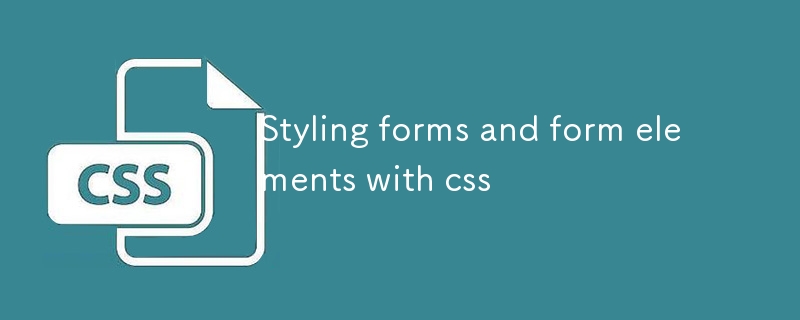
Styling forms and form elements with css
Article Introduction:To make the form more beautiful and improve the user experience, you can optimize it from the following four points: 1. Unify the basic style of the input box and add: focus effect; 2. Hide native check boxes and radio buttons and replace them with custom icons; 3. Set hover, active status and animation for the submission button; 4. Keep the form layout neatly and aligned, and use .form-group to uniform spacing.
2025-07-10
comment 0
566
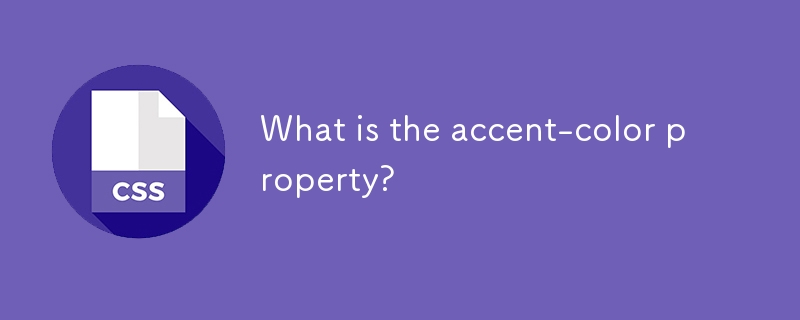
What is the accent-color property?
Article Introduction:accent-color is an attribute used in CSS to customize the highlight colors of form elements such as checkboxes, radio buttons and sliders; 1. It directly changes the default color of the selected state of the form control, such as changing the blue check mark of the checkbox to red; 2. Supported elements include input boxes of type="checkbox", type="radio" and type="range"; 3. Using accent-color can avoid complex custom styles and extra DOM structures, and maintain native accessibility; 4. It is generally supported by modern browsers, and old browsers need to be downgraded; 5. Set accent-col
2025-07-26
comment 0
795

Describe attribute selectors in CSS
Article Introduction:The CSS attribute selector locates and styles HTML elements through the attributes and values of the elements, without relying on classes or IDs. 1. You can select elements by whether there is a certain attribute, such as input[type] to select all input boxes with type attributes; 2. You can match exact values, such as input[type="text"] to only act on text input boxes; 3. Support partial matching, including ~= (space separation), |= (hyphen separation), and ^=, $=, *= (substring matching), which is suitable for multi-value attributes and complex condition filtering, but excessive use may affect performance. These selectors are suitable for handling forms, link filtering, image selection and other scenarios, making the structure simpler and requires no JavaScript
2025-07-16
comment 0
756

HTML `required` Attribute for Form Validation
Article Introduction:Use the required attribute of HTML to verify the required form. The basic usage is to add this attribute to the input, textarea or select element to ensure that the user can only allow submission after filling it out; 1. Support common input types such as text, email, password, number, date, textarea and select; 2. For radio buttons, you need to add required for radio to ensure that at least one is selected; 3. At least one must be selected after adding required for multiple selection boxes; 4. The default value of the select element cannot be an empty string, otherwise it will be considered unselected; mainstream browsers support required, but old versions may
2025-07-26
comment 0
406

how to create a form in word with drop-down lists and text fields
Article Introduction:Word forms can be collected by adding drop-down menus and text input boxes. 1. First enable the "Development Tools" tab: click "File" → "Options" → "Custom Ribbon" → check "Development Tools"; 2. Insert the drop-down menu: Select "Drop-down List Content Control" in the "Controls" group of "Development Tools", add options through "Properties" and set the default value; 3. Insert the text input box: Select "Text Content Control" or "Rich Text Content Control" to insert, for user free input; 4. Protect the form: Select "Fill in Form" through the "Restricted Editing" function and enable protection to prevent the format from being modified.
2025-07-28
comment 0
937

How can CSS be used to style form elements consistently across different browsers?
Article Introduction:To keep a form element consistent in style across different browsers, you must first reset the default browser style. The steps include: 1. Use CSS to reset or normalize.css to clear the default style; 2. Clearly set border, padding, margin, font-family and appearance attributes; 3. Customize the appearance of the input box after removing the native style; 4. Use pseudo-elements and hide the original input box to implement custom check boxes; 5. Make limited style modifications to the select element or use JavaScript to build a custom drop-down menu. These methods can achieve cross-browser consistency, but some complex elements such as select may require additional tool assistance.
2025-06-12
comment 0
1017

How to add custom fields to users
Article Introduction:To add custom user fields, you need to select the extension method according to the platform and pay attention to data verification and permission control. Common practices include: 1. Use additional tables or key-value pairs of the database to store information; 2. Add input boxes to the front end and integrate with the back end; 3. Constrain format checks and access permissions for sensitive data; 4. Update interfaces and templates to support new field display and editing, while taking into account mobile adaptation and user experience.
2025-07-06
comment 0
976

Advanced Java Exception Handling for Robust Applications
Article Introduction:Advanced skills in Java exception handling include using custom exception classes, exception wrappers, try-with-resources and reasonable selection of detected and non-tested exceptions. ① Improve semantic clarity and facilitate debugging by custom exception classes (such as inheriting RuntimeException or Exception); ② In a multi-layer architecture, exceptions should be packaged instead of "eat" and retain original information for troubleshooting; ③ Use try-with-resources to automatically close resources to prevent leakage and the code is concise; ④ Select detected or non-checked exceptions based on whether the caller needs to restore, so as to avoid excessive use of detected exceptions to increase complexity.
2025-07-19
comment 0
517

The `list` Attribute for HTML Input Fields
Article Introduction:The list property of HTML allows the input box to support "drop-down selection custom input", which is suitable for search boxes, form filling, configuration items and other scenarios. 1. It is achieved through association and implementation, and users can freely enter or select suggestions; 2. Pay attention to the good browser compatibility but the style is uncontrollable, the input content is not in the options, multiple selections are not supported, and mobile support is limited; 3. Optimization points include turning off autocomplete, rational layout of datalist, and combining JS dynamic update options to improve the experience.
2025-07-27
comment 0
213
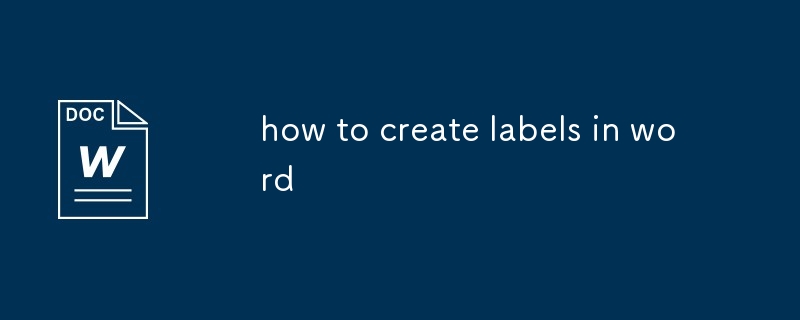
how to create labels in word
Article Introduction:Creating tags in Word can be achieved by using templates, custom formats, and batch generation. 1. Use the mail label template to quickly create standard mail labels, such as express delivery orders, directly search for "labels" to select the template and fill in information or use mail merge to generate batches; 2. Custom label format is suitable for special sizes, adjust the paper size through "page settings" and insert text boxes or tables to divide the label positions, set margins and fonts to ensure the printing effect; 3. Bulk generation can process the same content by copying and pasting the text box, or use mail merge to connect to Excel data sources to generate labels with different information, and click "Finish and Merge" to print or generate documents.
2025-07-26
comment 0
636

How do you handle multiple selections in a dropdown list in HTML?
Article Introduction:To implement the multiple selection function of HTML drop-down list, you need to use the multiple attribute, 1. Add the multiple attribute to the select tag to enable multiple selection; 2. You can set the size attribute to specify the number of visible rows to improve usability; 3. Note that native multiple selection is not good on touch screen devices, and you can consider using check boxes or modern components instead; 4. When submitting the form, the parameters of the same name will be sent repeatedly, and the backend needs to support multi-value processing, such as PHP requires the name="field[]" syntax; 5. The selected value array can be obtained through the selected Options attribute of JavaScript. Correctly configure the front and back ends and user experience details to complete the multi-select function.
2025-08-02
comment 0
217

What are the different input types in an HTML form
Article Introduction:There are 8 common input types in HTML forms, which are suitable for different data input requirements. 1.text is used for basic text input; 2.password is used to hide the password input displayed; 3.email is used to input email addresses specifically; 4.number is used for digital input and supports adjustment of numerical values; 5.checkbox is used for multiple selection check boxes; 6.radio is used for single-select button groups; 7.date provides date selection function; 8.submit is used to submit form data. Each type has its own specific uses and browser support features. Regular use can improve user experience and data processing efficiency.
2025-07-07
comment 0
945

Implementation method of multi-level linkage pull-down box between Vue and Element-UI
Article Introduction:How to use Element-UI in Vue to implement multi-stage linkage drop-down boxes? Use multiple El-Select components to bind data through v-model and use logic to control dynamic changes in options. Use a recursive function to efficiently generate and update the option list, dynamically update the options for subsequent drop-down boxes based on the selection results. Pay attention to the design of the data structure. A clear data structure can simplify the code logic. Considering performance issues when the data volume is large, use tree structure or virtual scrolling technology to optimize rendering. Handle errors to avoid program crashes. Pay attention to the readability and maintainability of the code, use meaningful variable names, add comments, and split the code into small, reusable functions.
2025-04-07
comment 0
457
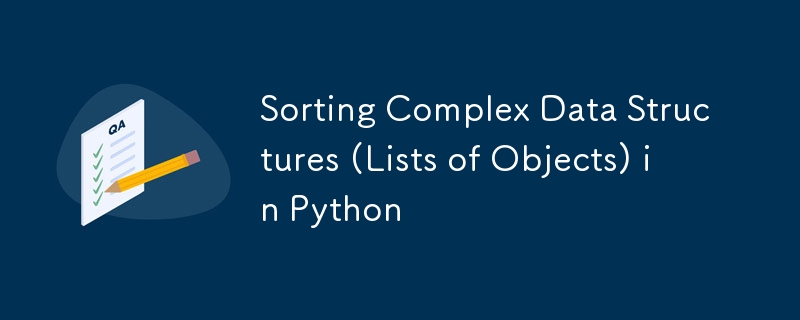
Sorting Complex Data Structures (Lists of Objects) in Python
Article Introduction:To sort the object list in Python, you need to use the sorted() function or .sort() method, and specify the object's properties or custom sorting logic through the key parameter. 1. Use lambda expression to select object attributes, such as key=lambdap:p.age; 2. Use square brackets to access fields for dictionary elements, such as key=lambdad:d['age']; 3. Support multi-level sorting, and return tuples in lambda in priority order, such as key=lambdap:(p.last_name,p.first_name); 4. Descending sorting can be achieved by setting reverse=True; 5. Custom functions can be used for complex sorting
2025-07-15
comment 0
539
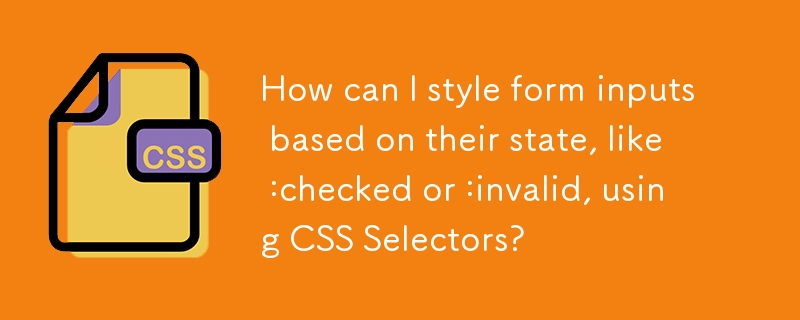
How can I style form inputs based on their state, like :checked or :invalid, using CSS Selectors?
Article Introduction:To style the different states of form input (such as selected, invalid or focused), the CSS pseudo-class should be used. 1. Use the checked pseudo-class to set styles for selected check boxes or radio buttons; 2. Use the:invalid pseudo-class to set styles for fields that have not passed the verification, combined with: user-invalid can be applied after user interaction; 3. Use the:focus and:hover pseudo-classes to enhance availability and accessibility; 4. Multiple pseudo-classes can be combined to implement multi-state style design, such as matching invalid and focused states at the same time. These methods can achieve dynamic style changes without JavaScript.
2025-07-01
comment 0
813

What are some other alternatives to Notepad, and what features do they offer?
Article Introduction:If you're looking for a tool that's more powerful than Notepad but doesn't want to use a complex editor, here are a few great options. 1.Notepad: Suitable for Windows users, supports syntax highlighting, plug-in extensions and multi-tagged editing. 2.SublimeText: Fast speed, supports fast navigation, multi-select editing and custom themes, suitable for processing code and text. 3.VisualStudioCode: a comprehensive code editor with built-in terminal, intelligent completion and debugging tools, suitable for developers. 4.Typora or FocusWriter: Focus on writing, provides a distraction-free interface and Markdown support to help you focus on content creation. Which tool to choose depends on your specific
2025-07-12
comment 0
154


















